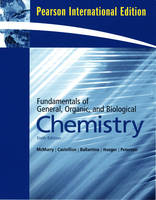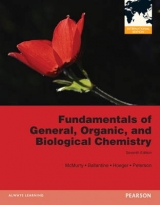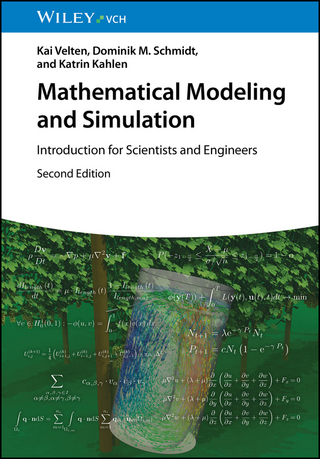
Fundamentals of General, Organic, and Biological Chemistry
Pearson (Verlag)
978-0-13-815228-4 (ISBN)
- Titel erscheint in neuer Auflage
- Artikel merken
This best-selling text bears the hallmark of all John McMurry’s books. On style, it is concise and avoids the `wordiness’ of most GOB texts. On substance, it is unusual in its balance of chemical concepts to explain the quantitative aspects of chemistry, and provides greater depth of insight into the theoretical chemical principles. This makes for a wider spectrum of the different angles from which to view chemistry, and thus, captures a greater number of students who can successfully learn from the book. Demanding, yet logical, it also sets itself apart by requiring students to master concepts before they can move on to the next chapter.
John McMurry: educated at Harvard and Columbia, has taught approximately 17,000 students in general and organic chemistry over a 30-year period. A Professor of Chemistry at Cornell University since 1980, Dr. McMurry previously spent 13 years on the faculty at the University of California at Santa Cruz. He has received numerous awards, including the Alfred P. Sloan Fellowship (1969–71), the National Institute of Health Career Development Award (1975–80), the Alexander von Humboldt Senior Scientist Award (1986–87), and the Max Planck Research Award (1991). Dr. David S. Ballantine, Jr., received his B.S. in Chemistry in 1977 from the College of William and Mary in Williamsburg, VA., and his Ph.D. in Chemistry in 1983 from the University of Maryland at College Park. After several years as a researcher at the Naval Research Labs in Washington DC he joined the faculty in the Department of Chemistry and Biochemistry of Northern Illinois University, where he has been a professor for the past twenty years. He was awarded the Excellence in Undergraduate Teaching Award in 1998, and was recently named the departmental Director of Undergraduate Studies. In addition, he is the faculty advisor to the NIU Chemistry Club, an ACS Student Affiliate program. Carl A. Hoeger received his BS in Chemistry from San Diego State Unversity and his Ph.D. in Organic Chemistry from the University of Wisconsin, Madison in 1983. After a postdoctoral stint at the University of California, Riverside, he joined the Peptide Biology Laboratory at the Salk Institute in 1985 where he ran the NIH Peptide Facility while doing basic research in the development of peptide agonists and antagonists. During this time he also taught general, organic, and biochemistry at San Diego City College, Palomar College, and Miramar College. He joined the teaching faculty at UCSD in 1998. Dr. Hoeger has been teaching chemistry to undergraduates for over 20 years, where he continues to explore the use of technology in the classroom. In 2004 he won the Paul and Barbara Saltman Distinguished Teaching Award from UCSD. His is currently the General Chemistry coordinator at UCSD, where he is also responsible for the training and guidance of the Chemistry and Biochemistry departments’ 100 + teaching assistants. Dr. Virginia E. Peterson received her B.S. in Chemistry in 1967 from the University of Washington in Seattle, and her Ph.D. in Biochemistry in 1980 from the University of Maryland at College Park. Between her undergraduate and graduate years she worked in lipid, diabetes and heart disease research at Stanford University. Following her Ph.D. she took a position in the Biochemistry Department at the University of Missouri in Columbia, and is an Associate Professor. Currently she is the Director of Undergraduate Advising for the department and teaches both senior capstone classes and biochemistry classes for non-science majors. Awards include both the college level and the university-wide Excellence in Teaching Award and, in 2006, the University’s Outstanding Advisor Award and the State of Missouri Outstanding University Advisor Award. Dr. Peterson believes in public service and in 2003 received the Silver Beaver Award for service from the Boy Scouts of America.
1. Matter and Life
1.1 Chemistry: The Central Science
1.2 States of Matter
1.3 Classification of Matter
1.4 An Example of a Chemical Reaction
1.5 Chemical Elements and Symbols
1.6 Elements and the Periodic Table
2. Measurements in Chemistry
2.1 Physical Quantities
2.2 Measuring Mass
2.3 Measuring Length and Volume
2.4 Measurement and Significant Figures
2.5 Scientific Notation
2.6 Rounding Off Numbers
2.7 Problem Solving: Converting a Quantity from One Unit to Another
2.8 Problem Solving: Estimating Answers
2.9 Measuring Temperature
2.10 Energy and Heat
2.11 Density
2.12 Specific Gravity
3. Atoms and the Periodic Table
3.1 Atomic Theory
3.2 Elements and Atomic Number
3.3 Isotopes and Atomic Weight
3.4 The Periodic Table
3.5 Some Characteristics of Different Groups
3.6 Electronic Structure of Atoms
3.7 Electron Configurations
3.8 Electron Configurations and the Periodic Table
3.9 Electron-Dot Symbols
4. Ionic Compounds
4.1 Ions
4.2 Periodic Properties and Ion Formation
4.3 Ionic Bonds
4.4 Some Properties of Ionic Compounds
4.5 Ions and the Octet Rule
4.6 Ions of Some Common Elements
4.7 Naming Ions
4.8 Polyatomic Ions
4.9 Formulas of Ionic Compounds
4.10 Naming Ionic Compounds
4.11 and Ions: An Introduction to Acids and Bases
5. Molecular Compounds
5.1 Covalent Bonds
5.2 Covalent Bonds and the Periodic Table
5.3 Multiple Covalent Bonds
5.4 Coordinate Covalent Bonds
5.5 Molecular Formulas and Lewis Structures
5.6 Drawing Lewis Structures
5.7 The Shapes of Molecules
5.8 Polar Covalent Bonds and Electronegativity
5.9 Polar Molecules
5.10 Naming Binary Molecular Compounds
5.11 Characteristics of Molecular Compounds
6. Chemical Reactions: Classification and Mass Relationships
6.1 Chemical Equations
6.2 Balancing Chemical Equations
6.3 Avogadro’s Number and the Mole
6.4 Gram–Mole Conversions
6.5 Mole Relationships and Chemical Equations
6.6 Mass Relationships and Chemical Equations
6.7 Limiting Reagent and Percent Yield
6.8 Classes of Chemical Reactions
6.9 Precipitation Reactions and Solubility Guidelines
6.10 Acids, Bases, and Neutralization Reactions
6.11 Redox Reactions
6.12 Recognizing Redox Reactions
6.13 Net Ionic Equations
7. Chemical Reactions: Energy, Rates, and Equilibrium
7.1 Energy and Chemical Bonds
7.2 Heat Changes during Chemical Reactions
7.3 Exothermic and Endothermic Reactions
7.4 Why Do Chemical Reactions Occur? Free Energy
7.5 How Do Chemical Reactions Occur? Reaction Rates
7.6 Effects of Temperature, Concentration, and Catalysts on Reaction Rates
7.7 Reversible Reactions and Chemical Equilibrium
7.8 Equilibrium Equations and Equilibrium Constants
7.9 Le Châtelier’s Principle: The Effect of Changing Conditions on Equilibria
8. Gases, Liquids, and Solids
8.1 States of Matter and Their Changes
8.2 Gases and the Kinetic–Molecular Theory
8.3 Pressure
8.4 Boyle’s Law: The Relation between Volume and Pressure
8.5 Charles’s Law: The Relation between Volume and Temperature
8.6 Gay-Lussac’s Law: The Relation between Pressure and Temperature
8.7 The Combined Gas Law
8.8 Avogadro’s Law: The Relation between Volume and Molar Amount
8.9 The Ideal Gas Law
8.10 Partial Pressure and Dalton’s Law
8.11 Intermolecular Forces
8.12 Liquids
8.13 Water: A Unique Liquid
8.14 Solids
8.15 Changes of State
9. Solutions
9.1 Mixtures and Solutions
9.2 The Solution Process
9.3 Solid Hydrates
9.4 Solubility
9.5 The Effect of Temperature on Solubility
9.6 The Effect of Pressure on Solubility: Henry’s Law
9.7 Units of Concentration
9.8 Dilution
9.9 Ions in Solution: Electrolytes
9.10 Electrolytes in Body Fluids: Equivalents and Milliequivalents
9.11 Properties of Solutions
9.12 Osmosis and Osmotic Pressure
9.13 Dialysis
10. Acids and Bases
10.1 Acids and Bases in Aqueous Solution
10.2 Some Common Acids and Bases
10.3 The Brønsted–Lowry Definition of Acids and Bases
10.4 Water as Both an Acid and a Base
10.5 Acid and Base Strength
10.6 Acid Dissociation Constants
10.7 Dissociation of Water
10.8 Measuring Acidity in Aqueous Solution: pH
10.9 Working with pH
10.10 Laboratory Determination of Acidity
10.11 Buffer Solutions
10.12 Buffers in the Body
10.13 Acid and Base Equivalents
10.14 Some Common Acid–Base Reactions
10.15 Titration
10.16 Acidity and Basicity of Salt Solutions
11. Nuclear Chemistry
11.1 Nuclear Reactions
11.2 The Discovery and Nature of Radioactivity
11.3 Stable and Unstable Isotopes
11.4 Nuclear Decay
11.5 Radioactive Half-Life
11.6 Radioactive Decay Series
11.7 Ionizing Radiation
11.8 Detecting Radiation
11.9 Measuring Radiation
11.10 Artificial Transmutation
11.11 Nuclear Fission and Nuclear Fusion
12. Introductions to Organic Chemistry:Alkanes
12.1 The Nature of Organic Molecules
12.2 Families of Organic Molecules: Functional Groups
12.3 The Structure of Organic Molecules: Alkanes and Their Isomers
12.4 Drawing Organic Structures
12.5 The Shapes of Organic Molecules
12.6 Naming Alkanes
12.7 Properties of Alkanes
12.8 Reactions of Alkanes
12.9 Cycloalkanes
12.10 Drawing and Naming Cycloalkanes
13. Alkenes, Alkynes, and Aromatic Compounds
13.1 Alkenes and Alkynes
13.2 Naming Alkenes and Alkynes
13.3 The Structure of Alkenes: Cis–Trans Isomerism
13.4 Properties of Alkenes and Alkynes
13.5 Types of Organic Reactions
13.6 Reactions of Alkenes and Alkynes
13.7 How Alkene Addition Reactions Occur
13.8 Alkene Polymers
13.9 Aromatic Compounds and the Structure of Benzene
13.10 Naming Aromatic Compounds
13.11 Reactions of Aromatic Compounds
14. Some Compounds with Oxygen, Sulfur, or a Halogen
14.1 Alcohols, Phenols, and Ethers
14.2 Some Common Alcohols
14.3 Naming Alcohols
14.4 Properties of Alcohols
14.5 Reactions of Alcohols
14.6 Phenols
14.7 Acidity of Alcohols and Phenols
14.8 Ethers
14.9 Thiols and Disulfides
14.10 Halogen-Containing Compounds
15. Amines
15.1 Amines
15.2 Properties of Amines
15.3 Heterocyclic Nitrogen Compounds
15.4 Basicity of Amines
15.5 Amine Salts
15.6 Amines in Plants: Alkaloids
16. Aldehydes and Ketones
16.1 The Carbonyl Group
16.2 Naming Aldehydes and Ketones
16.3 Properties of Aldehydes and Ketones
16.4 Some Common Aldehydes and Ketones
16.5 Oxidation of Aldehydes
16.6 Reduction of Aldehydes and Ketones
16.7 Addition of Alcohols: Hemiacetals and Acetals
17. Carboxylic Acids and Their Derivatives
17.1 Carboxylic Acids and Their Derivatives: Properties and Names
17.2 Some Common Carboxylic Acids
17.3 Acidity of Carboxylic Acids
17.4 Reactions of Carboxylic Acids: Ester and Amide Formation
17.5 Aspirin and Other Over-the-Counter Carboxylic Acid Derivatives
17.6 Hydrolysis of Esters and Amides
17.7 Polyamides and Polyesters
17.8 Phosphoric Acid Derivatives
18. Amino Acids and Proteins
18.1 An Introduction to Biochemistry
18.2 Protein Structure and Function: An Overview
18.3 Amino Acids
18.4 Acid–Base Properties of Amino Acids
18.5 Handedness
18.6 Molecular Handedness and Amino Acids
18.7 Primary Protein Structure
18.8 Shape-Determining Interactions in Proteins
18.9 Secondary Protein Structure
18.10 Tertiary Protein Structure
18.11 Quaternary Protein Structure
18.12 Chemical Properties of Proteins
19. Enzymes and Vitamins
19.1 Catalysis by Enzymes
19.2 Enzyme Cofactors
19.3 Enzyme Classification
19.4 How Enzymes Work
19.5 Effect of Concentration on Enzyme Activity
19.6 Effect of Temperature and pH on Enzyme Activity
19.7 Enzyme Regulation: Feedback and Allosteric Control
19.8 Enzyme Regulation: Inhibition
19.9 Enzyme Regulation: Covalent Modification and Genetic Control
19.10 Vitamins
20. Chemical Messengers: Hormones, Neurotransmitters, and Drugs
20.1 Messenger Molecules
20.2 Hormones and the Endocrine System
20.3 How Hormones Work: Epinephrine and Fight-or-Flight
20.4 Amino Acid Derivatives and Polypeptides as Hormones
20.5 Steroid Hormones
20.6 Neurotransmitters
20.7 How Neurotransmitters Work: Acetylcholine, Its Agonists and Antagonists
20.8 Histamine and Antihistamines
20.9 Serotonin, Norepinephrine, and Dopamine
20.10 Neuropeptides and Pain Relief
20.11 Drug Discovery and Drug Design
21. The Generation of Biochemical Energy
21.1 Energy and Life
21.2 Energy and Biochemical Reactions
21.3 Cells and Their Structure
21.4 An Overview of Metabolism and Energy Production
21.5 Strategies of Metabolism: ATP and Energy Transfer
21.6 Strategies of Metabolism: Metabolic Pathways and Coupled Reactions
21.7 Strategies of Metabolism: Oxidized and Reduced Coenzymes
21.8 The Citric Acid Cycle
21.9 The Electron-Transport Chain and ATP Production
21.10 Harmful Oxygen By-Products and Antioxidant Vitamins
22. Carbohydrates
22.1 An Introduction to Carbohydrates
22.2 Handedness of Carbohydrates
22.3 The D and L Families of Sugars: Drawing Sugar Molecules
22.4 Structure of Glucose and Other Monosaccharides
22.5 Some Important Monosaccharides
22.6 Reactions of Monosaccharides
22.7 Disaccharides
22.8 Variations on the Carbohydrate Theme
22.9 Some Important Polysaccharides
23. Carbohydrate Metabolism
23.1 Digestion of Carbohydrates
23.2 Glucose Metabolism: An Overview
23.3 Glycolysis
23.4 Entry of Other Sugars into Glycolysis
23.5 The Fate of Pyruvate
23.6 Energy Output in Complete Catabolism of Glucose
23.7 Regulation of Glucose Metabolism and Energy Production
23.8 Metabolism in Fasting and Starvation
23.9 Metabolism in Diabetes Mellitus
23.10 Glycogen Metabolism: Glycogenesis and Glycogenolysis
23.11 Gluconeogenesis: Glucose from Noncarbohydrates
24. Lipids
24.1 Structure and Classification of Lipids
24.2 Fatty Acids and Their Esters
24.3 Properties of Fats and Oils
24.4 Chemical Reactions of Triacylglycerols
24.5 Cell Membrane Lipids: Phospholipids and Glycolipids
24.6 Cell Membrane Lipids: Cholesterol
24.7 Structure of Cell Membranes
24.8 Transport Across Cell Membranes
24.9 Eicosanoids: Prostaglandins and Leukotrienes
25. Lipid Metabolism
25.1 Digestion of Triacylglycerols
25.2 Lipoproteins for Lipid Transport
25.3 Triacylglycerol Metabolism: An Overview
25.4 Storage and Mobilization of Triacylglycerols
25.5 Oxidation of Fatty Acids
25.6 Energy from Fatty Acid Oxidation
25.7 Ketone Bodies and Ketoacidosis
25.8 Biosynthesis of Fatty Acids
26. Nucleic Acids and Proteins
26.1 DNA, Chromosomes, and Genes
26.2 Composition of Nucleic Acids
26.3 The Structure of Nucleic Acid Chains
26.4 Base Pairing in DNA: The Watson–Crick Model
26.5 Nucleic Acids and Heredity
26.6 Replication of DNA
26.7 Structure and Function of RNA
26.8 Transcription: RNA Synthesis
26.9 The Genetic Code
26.10 Translation: Transfer RNA and Protein Synthesis
27. Genomics
27.1 Mapping the Human Genome
27.2 A Trip Along a Chromosome
27.3 Mutations and Polymorphisms
27.4 Recombinant DNA
27.5 Genomics: Using What We Know
28. Protein and Amino Acid
28.1 Digestion of Proteins
28.2 Amino Acid Metabolism: An Overview
28.3 Amino Acid Catabolism: The Amino Group
28.4 The Urea Cycle
28.5 Amino Acid Catabolism: The Carbon Atoms
28.6 Biosynthesis of Nonessential Amino Acids
29. Body Fluids
29.1 Body Water and Its Solutes
29.2 Fluid Balance
29.3 Blood
29.4 Plasma Proteins, White Blood Cells, and Immunity
29.5 Blood Clotting
29.6 Red Blood Cells and Blood Gases
29.7 The Kidney and Urine Formation
29.8 Urine Composition and Function
| Erscheint lt. Verlag | 5.3.2009 |
|---|---|
| Sprache | englisch |
| Maße | 216 x 275 mm |
| Gewicht | 1964 g |
| Themenwelt | Naturwissenschaften ► Chemie |
| ISBN-10 | 0-13-815228-4 / 0138152284 |
| ISBN-13 | 978-0-13-815228-4 / 9780138152284 |
| Zustand | Neuware |
| Informationen gemäß Produktsicherheitsverordnung (GPSR) | |
| Haben Sie eine Frage zum Produkt? |
aus dem Bereich



